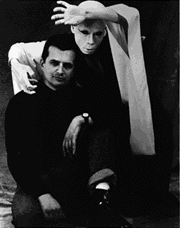|
Reviews:
Noise From Newcastle
England's NOCTURNAL EMISSIONS...evoke distinctly different noises that have long since made the term "industrial" obsolete. They conjure music for the mind, creating a meditative atmosphere that can help listeners take a closer look at themselves, their work has made them a highly regarded cult group in both Europe and the US, with people travelling miles to experience their live performances.
"Any fool can press a button. The point of technology is why and how you use it. Our work is a step beyond the myth of technology, behind the sales blurb, to see what it really does."
In 1985, Nocturnal Emissions' Nigel Ayers decided to stop playing in a group, strip down his own music, and tune back into the natural world, focusing on, as he stated in one interview his own "magickal development."
'"Development" may not be the best word,' Ayers elaborates. 'What I mean is an increased consciousness of what (Nocturnal Emissions) call the 'magical self' and its purpose. To me, this is to do with stripping away the programs of compromise as a social/economic unit and functioning in a completely made-up world of my own.
'Being tuned in is only a starting point. The goal with our work is to turn the world upside down and give it a good shaking.'
Ayers shook a few people's conceptions of music performance when he brought Nocturnal Emissions over for their first US tour last spring. The trio's stage set up was very simple, making the most out of a few elements, aiming to prove that they didn't need high-tech equipment to be effective.
During shows performed in Albany, Pittsburgh, Cleveland and Detroit, two members stood behind Ayers, operating small (as well as outdated) Casio SK5 keyboards. Meanwhile, Ayers quietly pushed the buttons and twirled the knobs of a very obsolete Korg synthesiser, which he had coincidentally borrowed that evening. Soothing, repetitious rumblings and other noises lasting in intervals of about ten to fifteen minutes emanated from the stage. To maintain the mood, Ayers even politely gestured to certain members of the audience to keep quiet. Physical movement was scarce that evening, save for a few glances at Ayers' keyboard by the other two members to reference what he was doing. Though the sounds seemed random, Ayers insisted that it was pre-planned.
'Although there is usually a good deal of improvisation involved in our shows,' he said later, 'the only spontaneity in that show was provided by a malfunctioning keyboard. Everything else was all pre-planned and carefully rehearsed.'
 | The band also did four nights of a different performance with the Dance Company Poppo and the Go Go Boys in New York City. Poppo, a Butoh dancer and choreographer from Japan currently living in New York, does a tradition of dance performance that began in Japan following World War II and the atomic bombings of Hiroshima and Nagasaki. Butoh involves elements of improvisation combined with extremes of physical and mental focus. |
Although Ayers' two companions revealed their names when asked in person after the show, it is important to the band that the members maintain a degree of anonymity. "It is Nocturnal Emissions policy not to discuss individual collaborators in the group," Ayers explains. "We find this distracts from the point of the project. Nocturnal Emissions has always existed in its own right, quite apart from any personalities involved. Anyone involved works as a caretaker for the project so it exists quite apart from individual egos."
Ayers formed Nocturnal Emissions in 1980, and the band has undergone three phases since that time. The first phase, what he calls the "post-industrial" phase from 1981 to 1984, was the most extreme and used mostly non-musical sound, voice collage, and overloaded electronic circuitry. From 1983 to 1985, the band went through its "funky" period, an accessible yet still uncompromising dance floor phase. Nocturnal Emissions has since evolved into its most current state, the "Neotantric" phase.
"This has seen the NEs using more natural sounds and minimalistic melodic structure in a quest for a new form of music," he describes in a self-written press kit. "It is a challenging and sophisticated music that regains a traditional magical and transformative function."
From Alternative Press #41,
September 1991
back
to Reviews index
|

